
Complete Overview and Installation of the Volant Intake on the 5th Gen 4Runner
The Volant Intake might be the perfect size for some, and it sounds great too!!
Coming in with a bigger airbox than the TRD Intake and a smaller airbox than the aFe intake, the Volant airbox sits right in the middle.
The Volant Intake has one notable difference over the TRD and the aFe, its RAM scoop. Do you see that large scoop covering the air injection pump? That is their RAM scoop.
We all know the 4Runner comes factory with a “cold air intake” so why buy another cold air intake?
MORE AIR!
Our factory intake has this massive clunky portion of plastic (intake resonator, and more officially a side branch resonator) that is designed to reduce the noise of the intake and improve efficiency.
The purpose of an intake resonator is to restrict airflow through the RPM spectrum and even more so through the powerband thus causing less intake noise (intake whistle) and hypothetically an increase in horsepower.
Why the Volant Intake?
It’s a complete kit that includes a closed filter box with dual air ducts pulling more air than traditional intakes, and Volants signature Pro5 filter.
At a glance:
- Volant 18840 Air Intake: Check Today’s Price
- Easy Install
- Improve Engine Operating Temperatures
- Improve Horsepower and Torque
- Made in the USA
Also, a special not for everyone in California, this cold air intake is not CARB compliant.
Tuning Required?
There is no tuning required, just install the new airbox and you are good to go! It’s a simple process and doesn’t need an expert.
Coming Straight From Volant:
The intake utilizes a high-velocity venturi filter adapter which provides a smooth transition through the MAF sensor into the intake tube for a much-needed airflow improvement over the factory rubber tubing and resonator box.
Volant’s Airbox is larger than the factory unit and incorporates a larger opening to collect a higher volume of colder ambient air. This model includes a Pro 5 filter which gets reoiled every 10,000 miles and serviced every 50,000 miles with cleaning kit P/N 5100. With Volant you have an intake that delivers excellent horsepower you can feel and fuel economy that puts some money back in your wallet. – https://volant.com/
Installation & Tool Check

Installation for this intake was much easier than the aFe intake as well as the TRD intake. If you looking for an easy to install the intake, this is the option for you.
In this step by step installation overview, you will see how simple the install was compared to the other two intakes we have installed so far.
No rerouting of wires or assembling tight parts.
This is a complete plug and play intake that took under 1 hour.
Preferred Tools
Not all needed, just what I used.
- 10mm-12mm socket
- Extension
- Screwdriver
- Milwaukee Screwdriver: Check Price
- Bent long nose pliers: Check Price
- Snap-On Light:
- Milwaukee Headlamp: Check Price
Pre Installation Step:
Before you begin the install you must disconnect the negative battery cable. Failure to disconnect the battery may cause a check engine light and/or damage to your engine. You also want to remove the engine cover before starting.
Step 1: Loosen the air duct to Throttle Body & Air Box
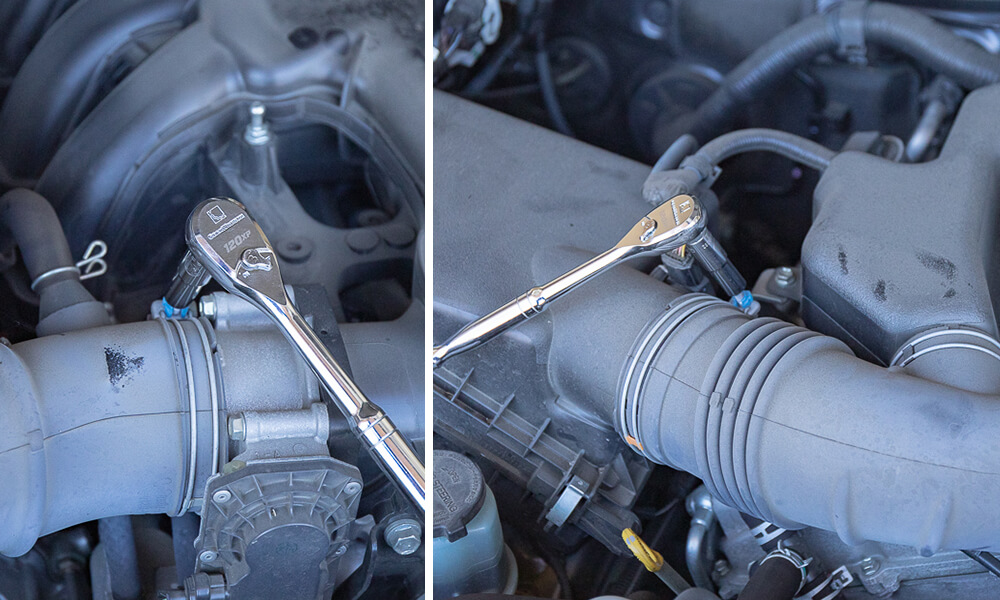
After removing the engine cover, loosen the clamp holding the air duct to the throttle body. Then, move over to the airbox, and loosen the clamp holding the air duct to the air box.
Step 2: Remove breather hoses
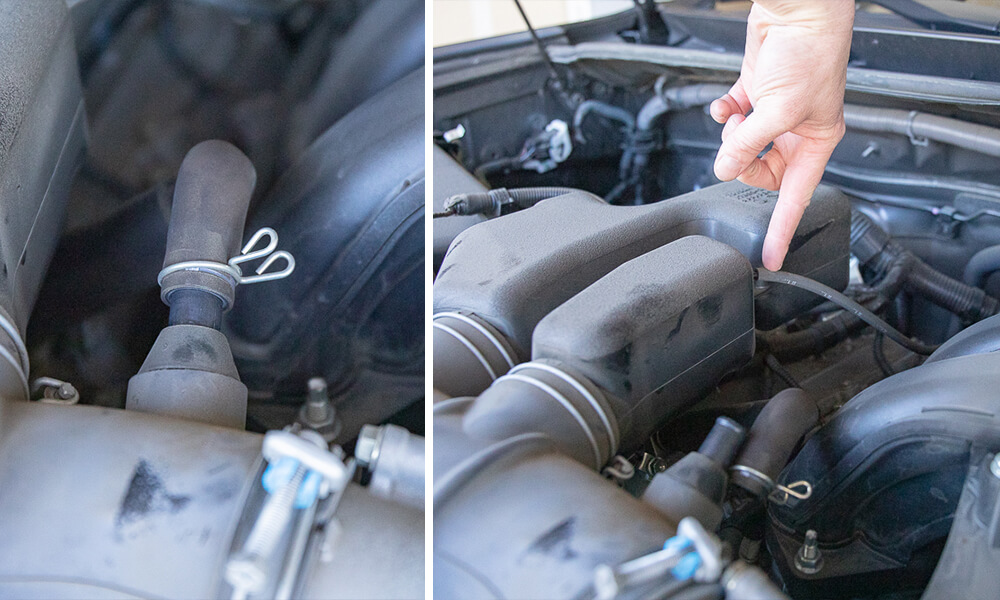
Using a set of pliers or even your hands, remove the factory 5/8 breather hose from the air duct (image left). Then remove the factory 1/8 breather hose from the resonator box (image right).
Step 3: Remove the factory wiring harness from the resonator box
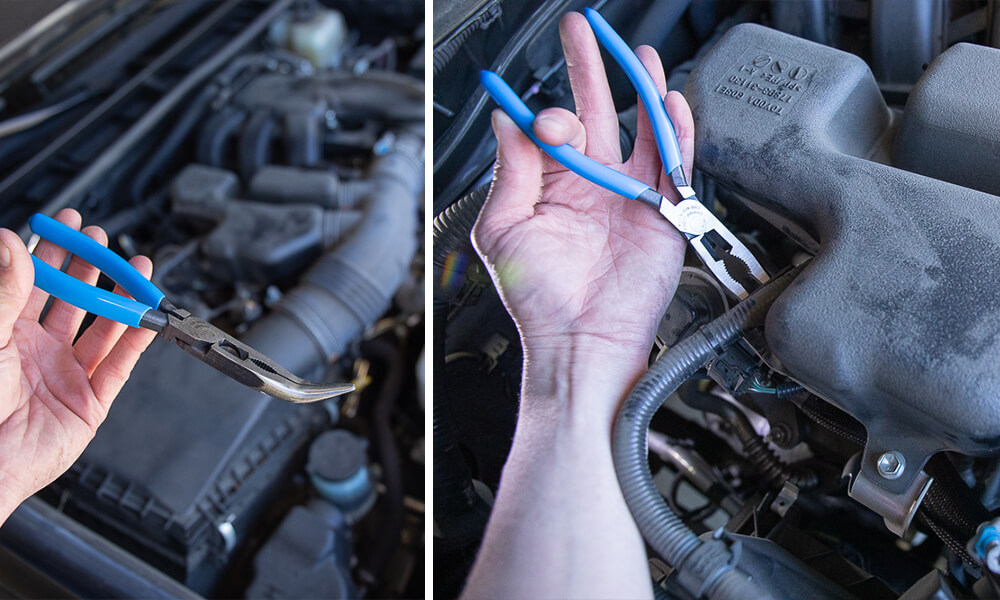
Using a set of bent needle nose pliers, remove the factory wiring harness from the resonator box. Everything in life is easier with a nice pair of bent needle nose pliers.
Step 4: Remove Inlet Tube
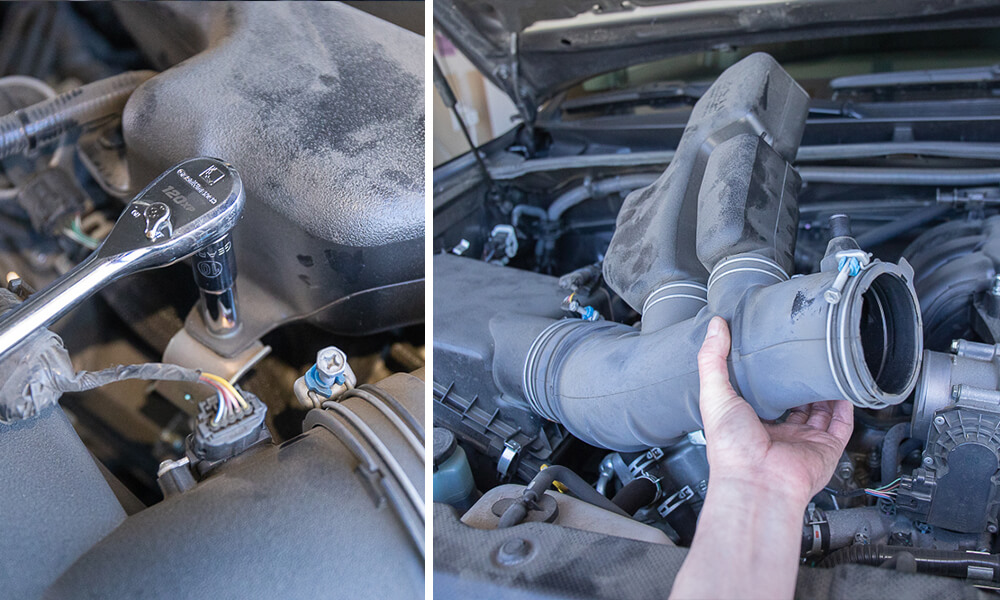
Remove the bolt holding the resonator box in place and then pull the factory air duct and resonator box. Save in case the vehicle needs to be returned to stock.
Step 5: Disconnect MAF (Mass Airflow Sensor)
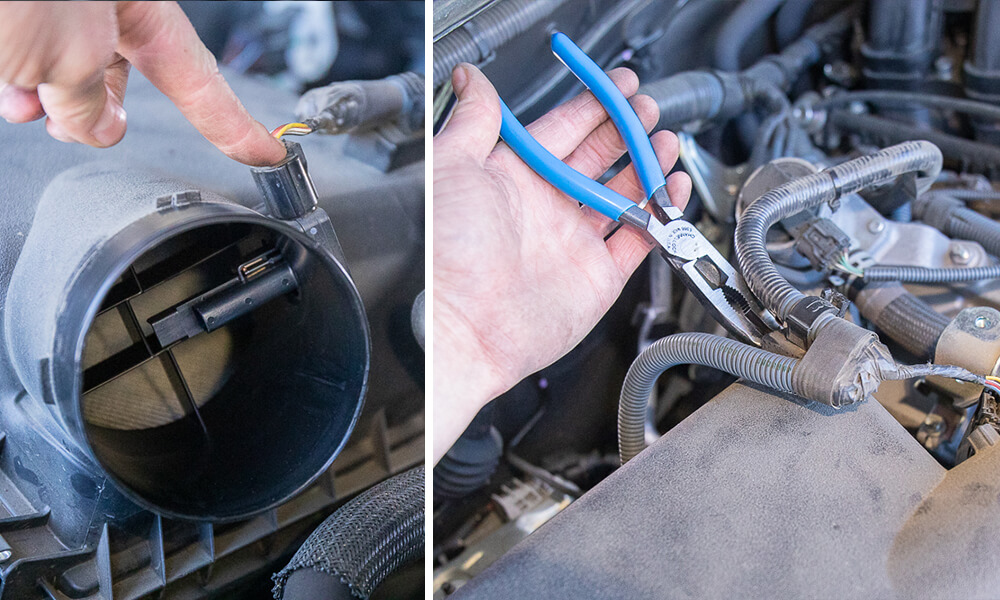
Disconnect the MAF sensor harness from the MAF sensor and then the MAF sensor harness from the top and back of the factory air box.
Step 6: Remove Air Box Lid, Unclip and Unbolt all Connections

Remove the factory lid and air filter from the factory airbox.
You should save all of these parts just in case you need to reuse in order to pass smog (especially if you live in California like us). Then remove the 2 bolts holding the lower half of the factory air box in place.
Save these factory bolts for reinstallation.
Step 7: Remove Resonator Bracket and Air Box
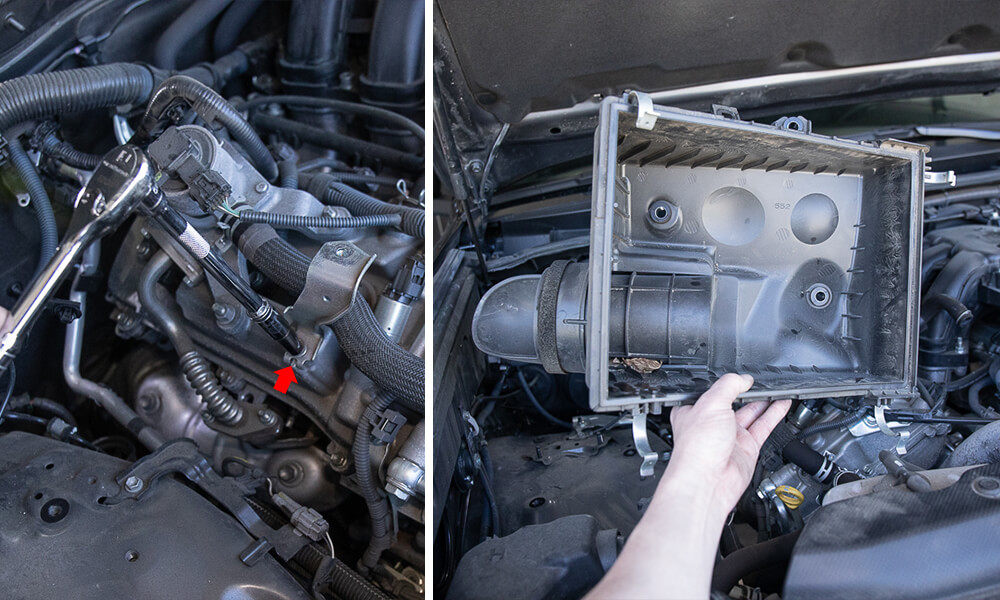
Remove the resonator air duct/inlet tube support bracket from the engine. Then remove the lower half of the factory air box. Again, save these parts in case the vehicle needs to be returned to stock.
Step 8: Insert new 1/8 breather hose
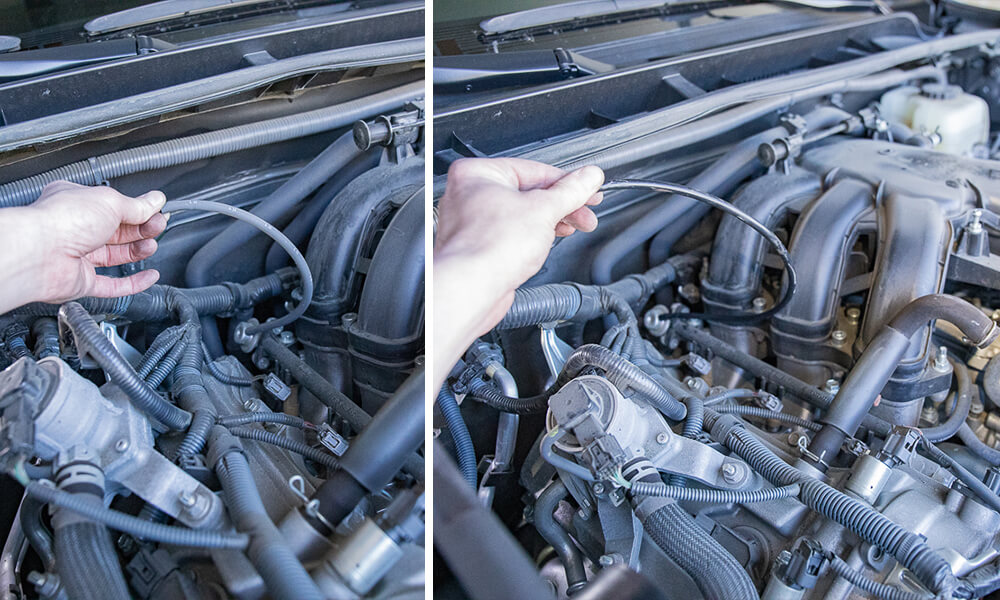
Remove the factory 1/8 breather hose from the engine (left) and save. Then install the supplied 1/8 x 16in breather hose onto the stock location (right).
Step 9: Remove and Install the MAF (Mass Airflow Sensor)

Remove the MAF sensor from the factory inlet tube and attach to the new inlet tube provided.
Step 10: Throttle Body, Air Box, and Ram Scoop Adapters

Step 11: Attach reducer to the throttle body

Attach the 3.5 to 3in reducer to the throttle body with the provided #48 clamp using a 5/16 socket or nut driver.
Step 12: Install the Air Duct/ Air Inlet Tube into Place

Slide the 4in hump hose and #64 clamps onto the filter end of the air duct and press the duct into the reducer.
Step 13: Attach Breather Hoses
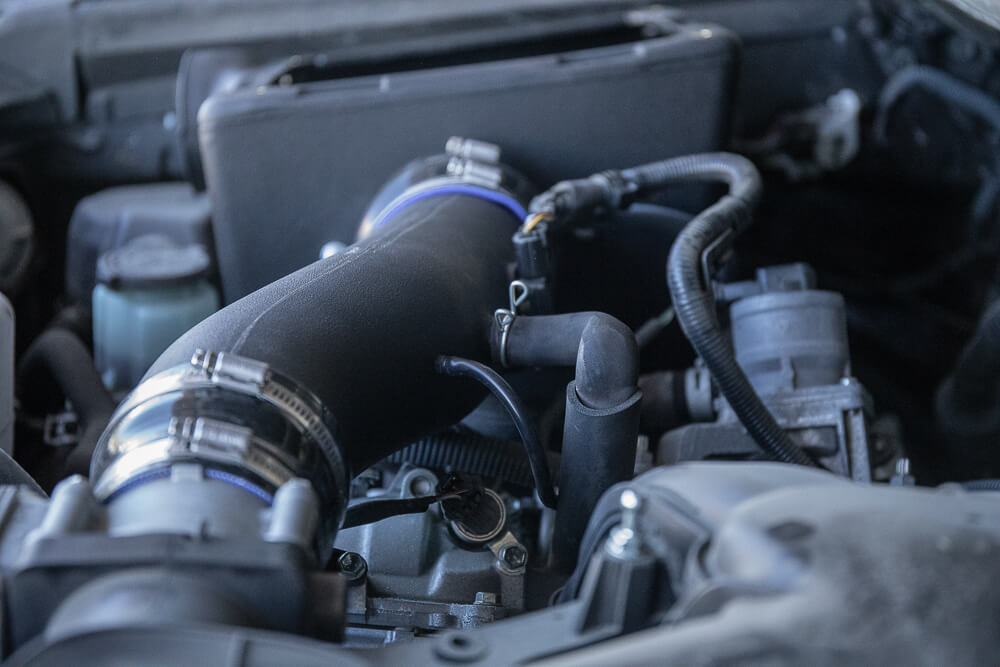
Plug the MAF sensor harness into the MAF sensor and then attach the factory 5/8 breather hose to the 5/8 stem on the Volant air duct. Continue to attach the final 1/8 breather hose to the 1/8 NPT fitting on the Volant air duct.
Step 14: Inset Ram Scoop
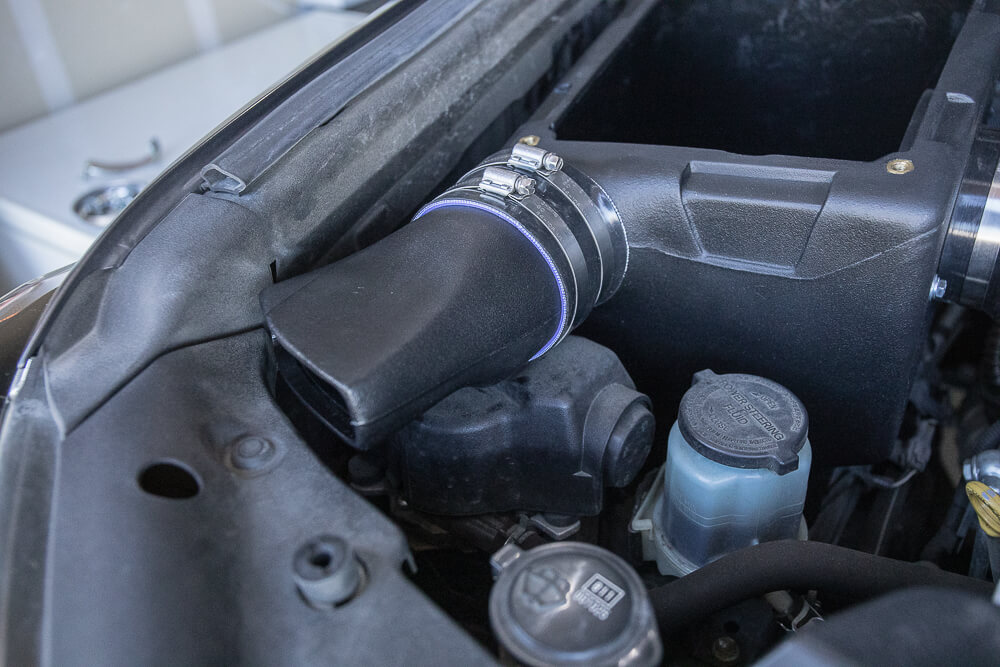
Attach the 3 3/4 x 2.5in sleeve onto the RAM airport on the Volant box with a #60 clamp using a 5/16 socket, or screwdriver.
Step 15: Add Intake Filter and Tighten with Provided Clamp

Slide the largest clamp and provided filter into place inside the Volant airbox.
Step 16: Choose Lid “Volant” Color
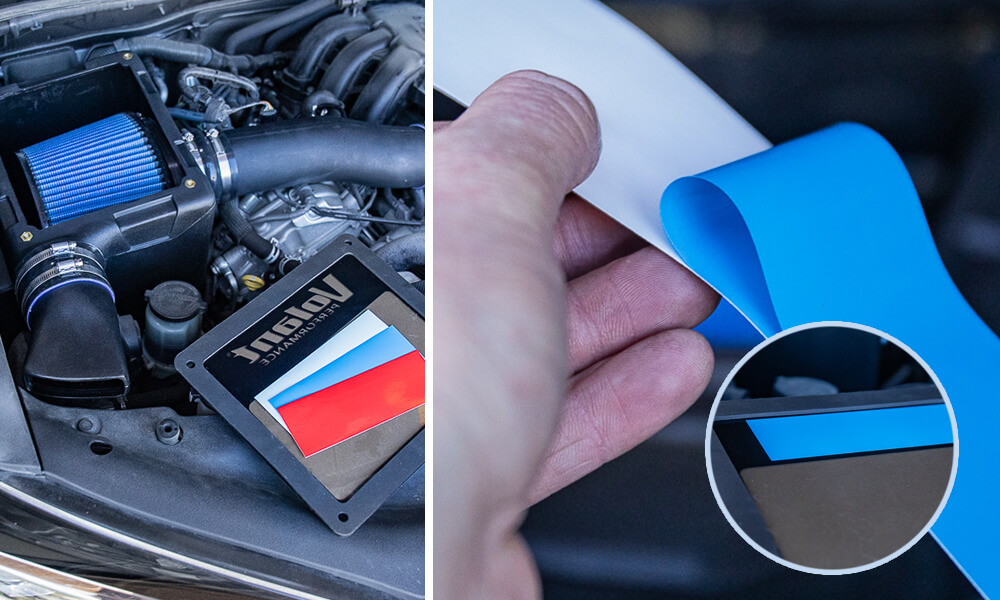
Volant provides you with a few different color options to choose from. You can go with white, red or blue.
Peel back the color of your choice and place upside down on the Volant airbox lid.
Volant Intake Measurements

The first measurement is from the airbox to the weather stripping. About 5.5″ give or take the wiring harness below, that can be relocated though.
The second measurement is from the airbox to the firewall. About 10″.
How does it sound?
Deeper and more throaty than the aFe and just about on par with the TRD intake. Both the TRD and this Volant intake have a deep mean throaty rumble around a wide range of the power band (3000-6000 RPMs).
The Volant intake has a wider range to be heard and felt on the power band, which comes out close to 3900 RPMs and lasts until you let off, unlike the aFe, coming in hot and alive around a more narrow band (5500-6000 RPMs).
The Volant Intake sounds great, is easy to install and will be a great option for many drivers looking for that added driving experience.
Did it improve HP?
Without a Dyno, it’s hard to say what the exact HP gains were. It would be nice to see a Dyno straight from Volant but I guess we will have to wait.
My first guess would be somewhere in the 10 range and more than likely 5-7 depending on the exhaust you are running and whether are not you are willing to get the truck tuned. Hopefully, we will be able to upload a Dyno sheet from Volant directly here soon.

Don’t buy these intakes! This company sucks and dosent care about Coustomer service. I emailed them about the same problem and they told me to return the product and move on.. Don’t waste your money here or you’ll be wishing you bought something better.
Yes, the email I received this morning from Volant was that I have their latest duct so they’re unsure why only some 4runners are getting the check Engine light. They currently don’t have a fix so I should return it. This sucks because the place I bought it from will only accept returns if it’s unused.
I did some research over the weekend and came upon a few youtube videos regarding intake honeycomb air straightener. What the air straightener is supposed to do is help distribute the air evenly. If you look in the stock air box, theres a plastic air straightener before the MAF sensor. I’m going to give this a try and hopefully it works. If it doesn’t, I guess I’ll be posting the intake on eBay.
Should’ve not cancelled my order with afe.
I have had the Volant CAI on my ’19 since about May of 2019. The CEL issue has gotten really bad lately so I contacted Volant to ask about an updated air duct. The reply stated that there is no improved duct and that I should try installing a “performance MAF sensor”. Found JET Powr-Flo #69160 works, but checking with JET I learned that they recommend only a dry-type filter element. Checking with Volant, I learned that they have no dry-type elements for the 18840 CAI.
So, has anyone found a dry element to replace the original? Hopefully a Donaldson brand.
Such a waste of time and money I also should have just bought the damn AFe as well. Guys don’t buy these stupid intakes not worth playing Russian Roulette with the Check engine light. I think at this point trying to make it work is stupid and only wasting more time and money I’m going to just throw it away so nobody else has this damn problem and make sure Volant will never get $1 from me or my friends. Goodluck man!
Hi Brenan, are you still running the Volant CAI? After seeing your article, I just purchased the CAI and installed it last night. After 30 mins of driving, I ran into the same issue you mentioned: Check Engine and TRAC OFF light came on. Do you know if the lights will clear itself if I keep driving the car or is the only fix is getting a new duct from Volant? Thanks!
Wondering if the new duct fixed the issue seen with the MAF?
It did on mine, yeah. No check engine light since.
What’s the difference between the air ducts? (Old style vs new style) I installed mine this September and after 20-30 miles I threw the infamous P0101 code. I’m also running a Borla exhaust, so maybe in/out volume is just too much for the stock ECU and MAF. Currently waiting on the URD MAF trick box to be shipped. Maybe that will be the ticket.
what all comes in the box??
putting on my truck and i just upgrade my throttle body
to bbk and i bought this and i got no info on what come in the box??
What needs to be done if my intake installer did not disconnect the battery or remove the engine cover? 🙄 my truck is now throwing codes. Check engine light is on which has disabled my traction control. Code Reads Mass or volume Air flow circuit range/performance. 🥺 2015 4Runner.
Disconnect the battery terminals for about 10 min then check the connection on the MAF (mass airflow sensor). Check and make sure that the MAF is fully seated into place and tightened down by those two small screws. Also, make sure all the hoses running to the intake are tight as well. Reconnect the battery terminals and see if that fixed the issue. Also, make sure your ram scoop is fully attached and tightened down. See STEP 14: INSET RAM SCOOP. If that is off or loose, you may throw codes as well.
Thank you! I figured rechecking the connections and such would be the next step. I did fully disconnect the battery yesterday and let it sit for about 30 minutes, hoping it would be as simple as that. Only for the codes to return last night. I’ll disconnect again and take a look at everything. Thank you again!
Hi Brenan,
Love all your posts on this site, been constantly going through them debating where to put my money. I now have the funds for a CAI and exhaust combo purchase to be installed at the same time to get the most of the combo. I want to do this before I start doing mods that will only increase weight and slow the girl down.
I have been debating between the TRD CAI and others until I read this post. Now I am debating between TRD CAI and the Volant. One question on the Volant, does the “Ram Air” pull in hotter air with the fender well since its directly in the engine bay?
Last post I saw, you had not installed an exhaust on the 4Runner with the Volant, have you done this yet? But based on your experience, what do you think would be the best combo between TRD CAI, Volant CAI, and Magnaflow or Boral exhaust? I have been a Borla guy all my life on V8, but like that Magnaflow seems to give a bit of a throatier sound on the 4Runner, but I don’t want to be drowned out on the highway.
Brandon, the Volant CAI has my firm vote man. Super easy install makes it a superior win over the TRD and it takes up a similar amount of real estate. Sounds deep and throaty at all RPMs and it comes alive at the power band. I would pair this with a Borla or Magnaflow, either one would be great. With Magnaflow, you will get a little more drone than Borla. I have had them both installed. I prefer the Magnaflow over the Borla though, it’s deeper and more throaty. As I’ve said many times, the Borla is a gentleman’s exhaust. It’s going to sound great, it’s just a bit more classy (less aggressive). The Magnaflow just has that mean, aggressive growl that no other exhaust has. Yeah, it can drone for sure.. especially at speeds on the freeway when your 4Runer won’t shift because you haven’t regarded. OK, that’s a story for another day. I think you get the point, Magnaflow drones more than Borla but Borla will never give you throat like Magnaflow.
Thanks Brenan, how does it compare to the TRD in the powerband, better/worse? Also, been reading a lot about the mounting holes not lining up. Did you experience that?
Without an exhaust paired on the Volant, it’s hard to compare 1:1. With that said, I would probably go with Volant over TRD because of the install process. Great throaty sound and once I get an exhaust on this truck, it should open up even more. Those holes at the bottom were tight for sure but once you get everything lined up and get that first thread in on the second bolt, drill it down and done.
On May 16th I commented that the CAI kit (at least the one that I received) did not “drop in”. I wrestled with the filter box trying to align its holes with the ones on my vehicle but the only way I could get them close resulted in the box being twisted. Then, after modifying the Volant’s mounting holes and moving on to the MAF sensor install on the kit’s duct did I run into the other issue. The Volant’s air duct has threaded brass inserts for attaching the Toyota MAF sensor. These inserts were installed such that when the sensor was dropped in, its mounting flange holes didn’t line up with the Volant’s inserts. Enlarging the sensor’s mounting holes allowed the screws to be installed.
Life is filled with learning curves and this was one for me. I could have stopped before I committed to surgery and contacted the seller – but where’s the challenge in that? Also, the kit that I purchased on Amazon was listed as “USED”. The kit may have been a return but the hardware was still in the sealed bags and nothing showed any signs of use. The problems I dealt with were manufacturing defects – like not using jigs to drill holes. Volant didn’t care to even discuss the kit’s defects as it was purchased as “USED”. The CAI is in, it works (the vehicle’s “MPG” reading immediately registered an increase), but I still question the manufacturing methods used by Volant.
Damn, that’s a bummer man. Our install could not have gone any smoother. This was literally the easiest intake I’ve installed out of four; TRD, aFe, and K&N.
It gets better. I’m writing this so if something similar happens to another Newbie they will have had a heads-up. In my last post I ended saying all was well, then last night while merging onto the I-17 in Phoenix I had to mash the throttle to avoid a car that wanted to be where I was before I could get somewhere else. This quick move to Wide Open Throttle resulted in the CHECK ENGINE light, TRAC OFF light and the MULTI-TERRAIN light being illuminated. At home, I stopped and restarted the engine and also operated the TRAC push button, but all remained the same. Manual says to see dealer if TRAC won’t reset – so I did. Big mistake! IMHO. Service report says problem caused by CAI. This info is now in my “file” at Toyota. Dealership didn’t clear the code(s)/ warning lights because they were “caused by the CAI”. Service Advisor said that the lights should clear themselves after a few “driving cycles”, which occurred the next time I restarted the engine after taking the vehicle home. The service tech said that most likely the computer got a signal from the MAF sensor that all was not okay. The WOT, positioning of the MAF sensor and the shape of the air duct possibly all contributed to an unusual air flow thus confusing the CPU.
Well, looks like I am in the same situation with our intake. I literally just got a call from the service tech giving me the same exact news. I thought this comment was him or something and then looked back at the date on your first comment. Crazy.
Hi Brennan,
If the problem only presents itself when the accelerator is depressed quickly and fully then I can live with that. This has been the only operational issue that I have had with the Volant CAI. I like that my MPG showed an immediate improvement after the CAI install and, perhaps, if I were to add a Sprint Booster the accelerator would not have to be “mashed” so violently to get a response.
I really like your site. Good objective info. Keep it up!
Guys at Volant were super cool and replied with the fact that it may be an issue with the duct and where the MAF screws down. Here is their reply “We are going to send you out a new duct and the MAF screws that come with it.” – I will update the page after we install the new duct (air inlet tube) as and the new MAF mount as soon as it comes in and update the post.
I had this same issue and they sent me a new duct within a couple days. Haven’t had a CEL ever since. That was about 4-5 months ago.
So is it you guys opinion to stick with this CAI, or switch to the TRD? Volant is going to be built this week and then shipped, so have time to switch before installing.
so do you like this CAI better than the TRD?
It’s hard to say without an exhaust installed. An aftermarket exhaust really helps bring everything together. I would say it’s right up there. The Volant wins because of the install time. It was quick and easy with no restructuring of wires. From what I have heard and felt with the Volant paired with the Sprint Booster, its a really nice throaty intake with great sound with a slight bump in HP felt.
This was my first after-market CAI install, so maybe what I experienced is “normal”. It seems, though, that for what one of these kits cost, it should pretty much bolt right up.
I needed the use of a die grinder and a Dremel tool to complete my install. The FilterBox mounting holes were not placed correctly and needed to be extended obliquely (die grinder) to allow the bolts to be inserted. The air duct’s MAF sensor mounting inserts did not match the sensor’s holes. I used the Dremel to modify the holes in the sensor’s flange. I also shortened the breather hose to eliminate its being kinked. Other than these issues all else appears fine. Any extra noise seems negligable and definitely not objectionable.
Tom, that’s not normal. You should hit up Volant and send them photos of your installation. They will make it right.
Any thoughts on installing this intake on a 4R that has a sprint booster? Not sure if it would create additional issues.
Chris, I have a pedal commander on with the TRD intake installed, its a must in my opinion. I will actually be installing the spring booster on this same 4Runner with the Volant Intake. We will see what happens but I am sure it will be a great addition with the added throttle response. It really makes the driving experience come alive.
Brenan, please record the sound if possible.
I’ll get to the YouTube clips eventually. Sorry about the lack of audio.
Did you have any issues with check engine light coming on after install?
No issues at all.
After about 50 miles after the install, my CEL and TRAC OFF lights came on. I am going to pull the MAF sensor and clean it as I have been told with oiled filters there can be oil residue that gets on it. Also going to triple check all of my connections and hoses to verify no leaks.
Any update here?
Any improvement in MPG?
Ray, no measured performance yet. I’ve been pretty heavy on the skinny pedal when driving this one.
Would this work with a snorkel?
Ben, Volant does not currently make a Snorkle kit but I am sure you can get a snorkel kit to work with the Intake as long as you can get creative with your own set of tube clamps and tube extensions (if needed at all).